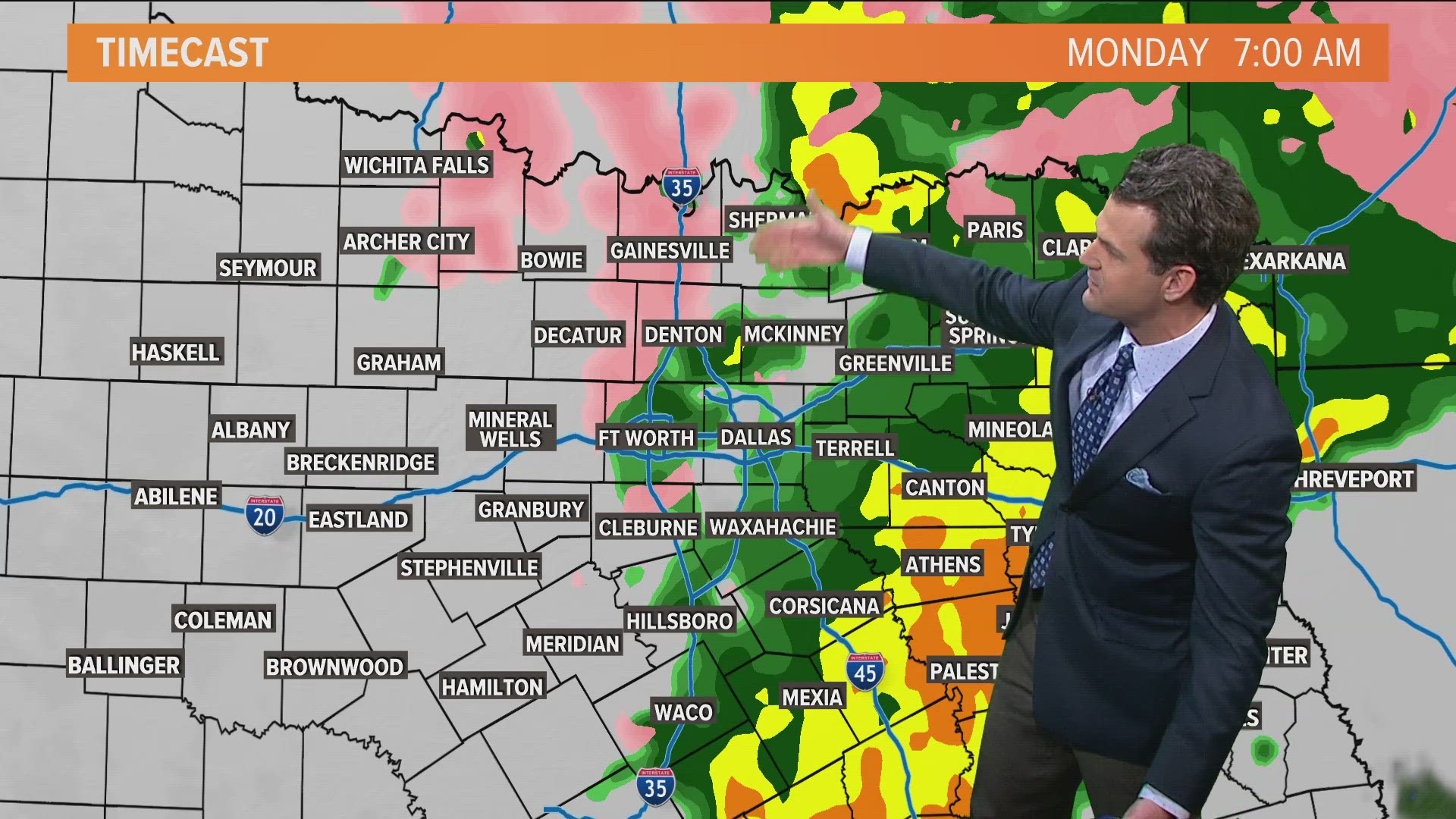DALLAS — A round of Arctic air will stick with us through the weekend.
Highs stay in the 30s this weekend with sunshine Saturday and clouds building on Sunday. Wintry precipitation is possible Sunday night into Monday morning. Get the latest weather forecast here.
There's a chance DFW never drops below freezing, but any areas in DFW that drop to freezing or below will have a chance for light freezing rain and slick spots on bridges and overpasses.
If temps stay at or below freezing in some areas Sunday afternoon and evening, those places may have to contend with some light freezing rain.
Whether you're a lifelong Texan or a new transplant, driving in the ice or snow in North Texas can be tricky – even if the accumulation on the roadways isn't much.
A prolonged period of ice can bring our highways to a standstill. Take 2013, for example, when bumpy, rock-hard "cobblestone ice" formed on the roads through partial melting and re-freezing.
The long and short of it: Just please stay off the roads, if you can.
If you can't, however, and you either don't have much experience driving in ice or just need a refresher, here a few key tips courtesy of AAA auto insurance.
Getting on the road
- If snow and ice accumulates on your vehicle, make sure you clean it off your hood, roof, trunk, lights and windows before hitting the road. This will keep you safe, through better visibility, and keep others safe around you, too.
- Greater snow accumulation might require you to clear a path around the wheels of your vehicle.
- This is important: If someone is helping push your vehicle out of its spot, do not let them stand directly ahead or behind the drive wheels. The spinning tires can throw objects and cause injury.
Following cars on the road
- Drivers should stay 8-10 seconds behind the car in front of them on icy or slippery surfaces.
- If you're on a four-lane highway, stay in the lane that was cleared most recently.
- Another important one: Do not use cruise control on an icy or slippery surface.
How to steer on ice and snow
- Avoid quick "jerky" movements of the steering wheel, which can cause skidding.
- If you have to avoid a collision, it might be better to steer rather than brake if you're driving more than 25 mph. Sudden braking could cause a loss of control.
- There are two methods of emergency steering that AAA recommends:
- The "push-pull-slide" method in which the driver shuffles their hands so that neither hand crosses over a line between the 12 and 6 on the steering wheel. This allows the driver to make continuous adjustments while steering, instead of major turns in either direction.
- The "fixed-hand" steering method allows for quick 180-degree steering turns but could result in your arms getting locked if you have to steer beyond 180 degrees.
How to brake on ice and snow
- If you don't have antilock brakes, you should do what's called "threshold braking," where you keep the heel of your foot on the floor and use the ball of your foot to put steady pressure on the brake. Do this to the threshold of what it would take to lock your brakes. Leaving your heel on the floor allows for more control of the brake to avoid locking it, according to AAA.
- If you have antilock brakes, keep your foot on the brake at all times. If you press the brake hard enough, your wheels might momentarily lock up and you'll feel the brake pedal vibrate. AAA emphasizes that this is normal. Do not pump the pedal at this point.
- The antilock brake system relieves just enough pressure to allow your wheels to start turning again, allowing you to steer as your vehicle slows down.
How to handle a skid on ice and snow
If you drive on icy roads long enough, a skid may be inevitable. There are several ways, according to AAA, you can handle this situation.
- If your car is in a rear-wheel skid, steer in the direction you want the front of your car to go. Do not slam on the brakes, as this will only make it harder to regain control. When your rear wheels stop skidding, keep steering to avoid a skid in the opposite direction.
- If your car is in a front-wheel skid, again steer in the direction you want the front of your car to go. When the front wheels regain their grip, the vehicle will be able to steer again. You can then steer the wheels in the direction you want. Unlike a rear-wheel skid, a front-wheel skid on a car with front-wheel drive, will not result in your car skidding in the opposite direction, as the front wheels will be locked.

